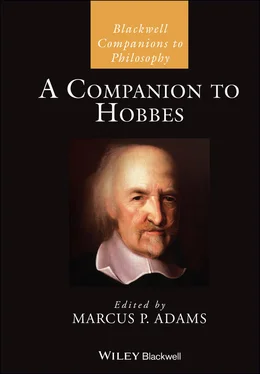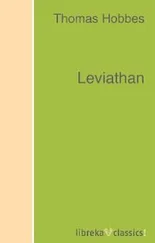1 ...8 9 10 12 13 14 ...48 Margaret Cavendish’s natural philosophy offers an interesting contrast to Hobbes’s since she understands all of nature to be matter but suggests that all motion happens by self -motion. In “Cavendish and Hobbes on Causation,” Marcy P. Lascano discusses Cavendish’s account of causation and contrasts it with Hobbes’s view of causation by means of an “entire cause.” Lascano focuses on perception, a key component of Cavendish’s natural philosophy, and shows that perceivers are not the entire cause of their perceptions. Against understanding Cavendish as advocating for a libertarian view of causation and of the parts of nature, Lascano links Cavendish to the Hobbesian account of liberty.
Spinoza’s debt to Hobbes is well known, in particular the appeal that both figures make to the concept of conatus (endeavor). Justin Steinberg’s chapter “Striving, Happiness, and the Good: Spinoza as Follower and Critic of Hobbes” shows how both Hobbes and Spinoza reject key features of Scholastic accounts of motivation. Both figures are determinists who dismiss free will and furthermore deny appeals to final causes, offering instead reductive accounts of ends by appealing only to efficient causes. However, after exposing these similarities, Steinberg argues that Spinoza’s naturalistic eudaimonism leads him to have views different from Hobbes concerning goodness, happiness, liberty, and the function of the state.
Scholars of Mary Astell have noted how in some of her well-known works, such as A Serious Proposal to the Ladies , Parts I and II , she criticizes Hobbesian ideas, in particular those related to the natural state of humans and the social contract needed for leaving that state. Jacqueline Broad’s chapter “Hobbes and Astell on War and Peace” shows that in three political pamphlets of Astell’s from 1704 she also engages with Hobbesian ideas related to war and peace. Although Astell seeks to distance herself from Hobbes’s philosophy, Broad shows how Astell adopts aspects of his view and even extends his ideas to claim that sexist opinions about female sovereigns and about women’s susceptibility to seditious opinion represent a threat to social order.
David Hume’s account of selfishness and human nature has been contrasted with Hobbes’s, with the latter sometimes viewed as an egoist. Alexandra Chadwick’s chapter “Hobbes and Hume on Human Nature: ‘Much of a Dispute of Words’?” challenges this conception of Hobbes, showing that the differences between Hobbes and Hume on selfishness become less clear when examining their philosophical psychology. Chadwick argues that instead the difference lies in Hobbes’s rhetorical aim: Hobbes believes it dangerous to think too highly of human nature. When Hobbes presents individuals who claim to have the interests of the people in mind as driven by self-serving desires, he seeks to discourage citizens from listening to them.
In the chapter “He Shows ‘Genius’ and Is ‘More Useful than Pufendorf’: Kant’s Reception of Hobbes,” Howard Williams examines Kant’s reaction to Hobbes’s view that open public inquiry can endanger society. Whereas Kant held that such debate among scholars was an essential feature of healthy society, Kant saw Hobbes as wrongly vesting all power in the sovereign to decide what viewpoints may be heard. Alongside this disagreement with Hobbes, Williams shows that Kant agreed with Hobbes on the sovereign’s authority being unchallengeable; Kant’s claim that open debate was necessary did not allow resistance to the sovereign but implied only a right to communicate. Williams concludes by considering Kant’s rejection both of Hobbes’s methodology and Hobbes’s reliance upon philosophical psychology to understand human nature.
Karen Green’s chapter “Catharine Macaulay and the Reception of Hobbes during the Eighteenth Century” shows that although critics of liberal democracy have represented it as grounded in Hobbes’s philosophy, the role Hobbes played was not so direct. Green shows that instead Macaulay’s view looked forward to a democratic commonwealth, in which the common good would be the common care, and she based her advocacy of democratic institutions in natural law, rational religion, Christian eudaimonism , and rational altruism. Green suggests that subsequent philosophical developments help explain why Hobbes came take on the central philosophical position that he currently occupies.
3 Strategies for Unity among the Parts of Hobbes’s Philosophy
The earlier discussion of the Table in Leviathan 9 suggested that it does not show the structure of Hobbes’s philosophy. If the Table does not display this, what are strategies for understanding how the parts of Hobbes’s philosophy fit together? For example, how does Hobbes’s civil philosophy relate to his claims about human nature? Or how is Hobbes’s natural philosophy dependent upon geometry or first philosophy? Although Hobbes provides some clues at several points in his writings, there is no largely agreed-upon strategy among Hobbes scholars of accounting for how the different parts of his philosophy depend upon one another.
In terms of the number of its adherents, perhaps the best-represented account of how the parts of Hobbes’s philosophy fit together is what might be called the “deductivist” interpretation of Hobbes’s philosophy. Those holding the deductivist interpretation often appeal to De corpore VI.6 13and broadly see Hobbes as holding something like the following viewpoint: claims in civil philosophy would be deduced from “morals” (the term Hobbes uses to describe the part of philosophy that considers desire and aversion, as well as the passions generally); claims in “morals” would be deduced from claims in natural philosophy; and claims in natural philosophy would be deduced from geometry and, ultimately, from first philosophy (Hobbes’s preferred term for his metaphysics).
Scholars who understand Hobbes in this way have focused both on the shape of his philosophy overall as well as on the relationships among parts of it. For example, in their account of the debate between Hobbes and Robert Boyle concerning the air-pump experiments, Steven Shapin and Simon Schaffer describe Boyle as “protecting the proper procedures of experimental philosophy against the beast of deductivism” (Shapin and Schaffer 1985, 176). On the move from philosophical psychology to civil philosophy (this is the fault line in Hobbes’s thought, described already), and how this relates to deduction, there has been significant disagreement among commentators. In particular, if one holds that Hobbes’s claims in civil philosophy are grounded in moral claims then, if one simultaneously holds the deductivist interpretation, the question of the ground of those moral claims is pressing, since it appears that Hobbes would be guilty of deriving ought-statements from is-statements. In other words, Hobbes would appear to be committing a version of the so-called naturalistic fallacy. R.S. Peters argues that such a deduction was Hobbes’s intent and that Hobbes falls prey to this fallacy, asserting that “Hobbes seems to have thought that the basic prescription ‘men ought to endeavour peace’ can be deduced from psychology and physics. This seems to be a logical mistake” (1956, 171). J.W.N. Watkins agrees that Hobbes’s aim was to deduce civil philosophy from philosophical psychology, but Watkins attempts to remove the worry by arguing that Hobbes avoided the fallacy by having “prescriptions [that] are not moral prescriptions—they are more like ‘doctor’s orders’ of a peculiarly compelling kind” (1965, 76; emphasis original).
The framing of this debate, focusing on the transition from Hobbes’s philosophical psychology to his civil philosophy, is reflective of controversy surrounding an influential paper by A.E. Taylor that advanced what Hobbes scholars have come to refer to as “the Taylor thesis.” 14Taylor argued that “Hobbes’s ethical doctrine proper, disengaged from an egoistic psychology with which it has no logically necessary connection , is a very strict deontology, curiously suggestive, though with interesting differences, of some of the characteristic theses of Kant” (1938, 408; emphasis added). Despite Taylor’s worries, Howard Warrender saw a role for Hobbes’s philosophical psychology insofar as it could serve as one of the “validating conditions” of Hobbes’s account of obligation to obey the law since, given Warrender’s view that Hobbes was committed to the principle that ought implies can, it was necessary to show humans “capable of having an adequate motive to obey it” (1957, 87). 15
Читать дальше












